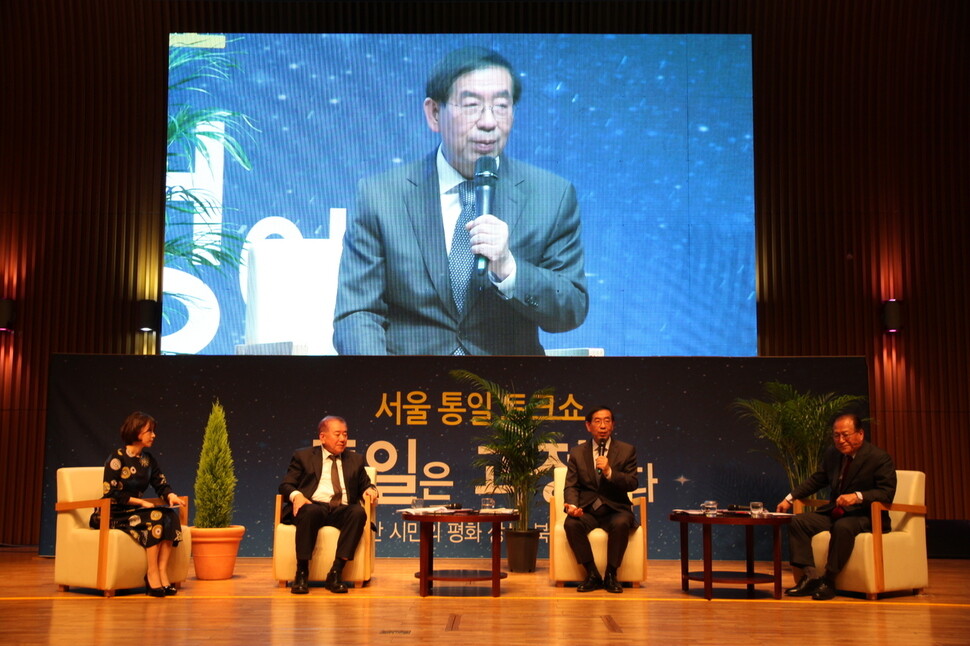hankyoreh
Links to other country sites 다른 나라 사이트 링크
Seoul Mayor voices 'northern new deal' plan for unification with North Korea

“Let’s implement the ‘northern new deal’ by improving inter-Korean relations through the ‘P-turn plan’ and establish a lasting peace through the ‘three-horse carriage policy.’”
During a keynote speech and debate in the “unification talk show” held on the eight floor of Seoul City Hall on Nov. 24, Seoul mayor Park Won-soon summarized his policy plan for the Korean Peninsula [with the keywords] “northern new deal,” “P-turn plan,” and “three-horse carriage policy.”
The talk shows series was organized by the Hankyoreh Foundation for Reunification and Culture and the Korea Peace Forum to give presidential candidates and other major politicians a chance to talk about their policy platforms for the Korean Peninsula. This talk show was the fourth to be held, following one by Minjoo Party lawmaker Jeong Dong-yeong in Jeonju, North Jeolla Province, on Aug. 15; South Chungcheong Province governor Ahn Hee-jung in Asan, South Chungcheong Province, on Oct. 4; and Seongnam mayor Lee Jae-myung in Seongnam, Gyeonggi Province, on Oct. 14.
Park’s “northern new deal” represents the idea of using North Korea as a bridge to expand into Eurasia. “Given that the South Korean economy is stuck in a low-growth morass, expanding to the north is no longer optional – it’s essential,” the mayor said.
Citing news reports suggesting that plans are underway to use bridges and tunnels to link Russia’s Trans-Siberian Railway to the Japanese island of Hokkaido, Park expressed concerns that this would make “not Japan but South Korea the real island.”
Park criticized the current administration for being “fools or unpatriotic race traitors” for “squandering the opportunity to move north by weakening relations with North Korea.”
The “P-turn plan” is an approach that would make possible the “northern new deal.” This would constitute a grand shift in North Korean policy away from pressure and toward peace.
“President Park Geun-hye talks about ‘unification as a jackpot,’ but with inter-Korean relations at such an impasse, this is more like bankruptcy,” Park Won-soon said. To bring about the shift toward a policy of peace, Park argued that the South “should start doing what can be done right away.” The starting point, he said, was “immediately rescinding the May 24 Measures [sanctions barring inter-Korean trade] and resuming humanitarian aid.”
Park’s third keyword – the “three-horse carriage” – means that the central government, local government and civic society each have a role to play in bringing peace to the Korean Peninsula.
“The central government should make the overarching guidelines and infrastructure, local government should strengthen relations between cities in North and South Korea, and civic society and companies in the private sector should flesh out those plans,” Park said. He believes that these conditions must be met if peaceful relations between North and South Korea are to survive the ups and downs of new administrations.
In relation to this, Park recently announced plans to “establish a wide-ranging cooperative relationship between Seoul and Pyongyang in areas such as the economy, culture and sports.”
Former unification minister Jeong Se-hyun and Yonsei University professor Moon Chung-in took part in the debate on Nov. 25.
By Kim Bo-geun, senior staff writer
Please direct questions or comments to [english@hani.co.kr]

Editorial・opinion
![[Column] Has Korea, too, crossed the Rubicon on China? [Column] Has Korea, too, crossed the Rubicon on China?](https://flexible.img.hani.co.kr/flexible/normal/500/300/imgdb/original/2024/0419/9317135153409185.jpg) [Column] Has Korea, too, crossed the Rubicon on China?
[Column] Has Korea, too, crossed the Rubicon on China?![[Correspondent’s column] In Japan’s alliance with US, echoes of its past alliances with UK [Correspondent’s column] In Japan’s alliance with US, echoes of its past alliances with UK](https://flexible.img.hani.co.kr/flexible/normal/500/300/imgdb/original/2024/0419/2317135166563519.jpg) [Correspondent’s column] In Japan’s alliance with US, echoes of its past alliances with UK
[Correspondent’s column] In Japan’s alliance with US, echoes of its past alliances with UK- [Editorial] Does Yoon think the Korean public is wrong?
- [Editorial] As it bolsters its alliance with US, Japan must be accountable for past
- [Guest essay] Amending the Constitution is Yoon’s key to leaving office in public’s good graces
- [Editorial] 10 years on, lessons of Sewol tragedy must never be forgotten
- [Column] A death blow to Korea’s prosecutor politics
- [Correspondent’s column] The US and the end of Japanese pacifism
- [Guest essay] How Korea turned its trainee doctors into monsters
- [Guest essay] As someone who helped forge Seoul-Moscow ties, their status today troubles me
Most viewed articles
- 1[Column] The clock is ticking for Korea’s first lady
- 2After 2 months of delayed, denied medical care, Koreans worry worst may be yet to come
- 3[Column] Has Korea, too, crossed the Rubicon on China?
- 4US overtakes China as Korea’s top export market, prompting trade sanction jitters
- 5[Editorial] When the choice is kids or career, Korea will never overcome birth rate woes
- 6[Correspondent’s column] In Japan’s alliance with US, echoes of its past alliances with UK
- 7[Photo] Smile ambassador, you’re on camera
- 8Hong Se-hwa, voice for tolerance whose memoir of exile touched a chord, dies at 76
- 9Nearly 1 in 5 N. Korean defectors say they regret coming to S. Korea
- 10Strong dollar isn’t all that’s pushing won exchange rate into to 1,400 range